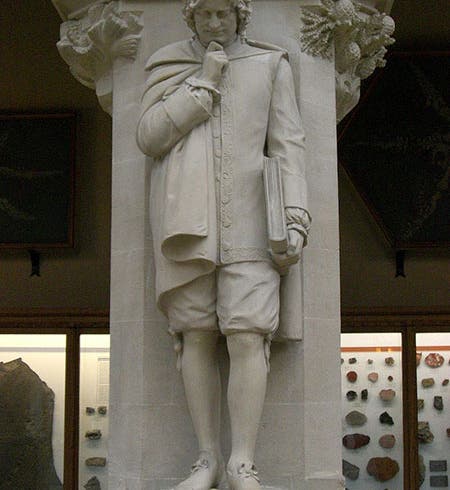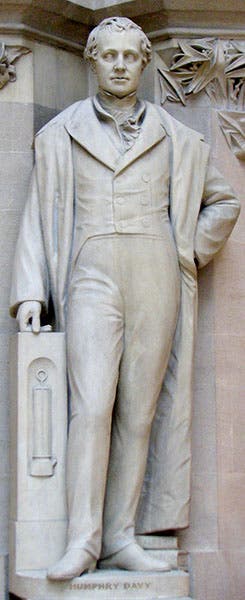Scientist of the Day - Alexander Munro
Alexander Munro, an English sculptor, was born Oct. 26, 1825. Munro was a member of the Pre-Raphaelite movement and a friend of Thomas Woolner, another Pre-Raphaelite sculptor. Around 1854, work began on the Oxford University Museum of Natural History, designed by Irish architect Benjamin Woodward with the advice of John Ruskin, and since Pre-Raphaelite influence was evident in many parts of the building, such as the naturalistic carvings around the doorways, it is not surprising that Munro and Woolner and several others were invited to carve statues of notable historical scientists to line the aisles around the interior courtyard. Of the 19 statues commissioned, Munro was assigned (or chose) six: Hippocrates, Galileo, Isaac Newton (first image), Gottfried Leibniz, James Watt, and Humphry Davy (second image). We show here two of the six: Newton and Davy; the other four have links. Each statue has an emblematic attribute to represent that person’s contribution to science; for Newton, it is an apple, sitting at his feet; for Davy, it is his miner’s safety lamp.
The Museum is a gorgeous example of Victorian architecture and decoration at its finest. In addition to the statues (and 9 busts), there are 30 stone columns inside, each made of a different English stone, with carved capitals, each depicting a different English plant. The stone columns were selected by geologist John Phillips. We managed to write a post on Phillips six years ago without mentioning the Oxford Museum columns, which was a glaring omission. But that was early in this blog's career; when we redo that post, we will be sure to include (and illustrate) Phillips’ geological columns.
When you visit the museum, it is possible not to notice the statues, since they stand behind magnificent dinosaur skeletons and other marvels of nature (third image). So be sure to look for them. Here is an excellent guide to all the statues and busts, compiled by the Oxford University Museum. You might notice that all but one of the statues are carved from Caen stone, an ivory-colored oolitic limestone that comes from Normandy. It was chosen because it occupies the same stratum as the native Oxford oolite, which was where the first dinosaur, Megalosaurus, was discovered, and is thus the same age as one of the Oxford Museum's great treasures. That kind of attention to detail and nuance is what puts the Oxford University Museum of Natural History right at the top of anyone's list of great scientific buildings. You should be careful not to confuse Alexander Munro, sculptor, with any of the three Alexander Monros, anatomists, who taught at Edinburgh University for well over a century. You can find many busts and portraits of the anatomical Monros, but none, alas, of our sculptor. His Oxford statues will have to stand by themselves as monuments to his creative genius. Dr. William B. Ashworth, Jr., Consultant for the History of Science, Linda Hall Library and Associate Professor emeritus, Department of History, University of Missouri-Kansas City. Comments or corrections are welcome; please direct to ashworthw@umkc.edu.







![Columbine, hand-colored woodcut, [Gart der Gesundheit], printed by Peter Schoeffer, Mainz, chap. 162, 1485 (Linda Hall Library)](https://assets-us-01.kc-usercontent.com:443/9dd25524-761a-000d-d79f-86a5086d4774/3829b99e-a030-4a36-8bdd-27295454c30c/gart1.jpg?w=210&h=210&auto=format&fit=crop)
